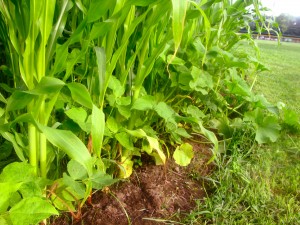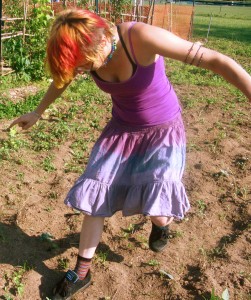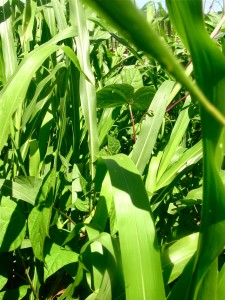Growing the Three Sisters
They are the Holy Trinity of the First Peoples.
Corn, beans and squash.
There are many Native American tales, most of them originating among the Eastern tribes, about the Three Sisters. Some say that they existed as soon as land was separated from the sea. The Iroquois tell that they sprang from the body of Sky Woman’s (the mother of all humanity) daughter, after she died in childbirth. After she was buried, three plant sisters sprang up from the ground–one tall and dressed in pale green with long yellow hair, another who loved to hug and cling to her big sister, with a yellowish green dress dotted with purple and white flowers, and the third who was so young she could only crawl on the ground who wore a dark green dress, and liked to circle her sisters’ ankles and playfully pat their dresses. These three sisters fed the sons of Sky Woman’s daughter, and later, the rest of humanity, but they never, ever liked to be taken one from the other.
Always the Three Sisters stayed together, and if their wishes to be never parted were respected by their human brothers and sisters, they would reward them with great harvests and full bellies.
I may not look it myself, being pale of skin, hair and yes, but I am of Cherokee ancestry, and so I’ve always had a great respect and love for the ways of the First Peoples of our nation. When I was a Girl Scout, way back in the day, one of the first merit badges I chose to fulfill was the American Indian one–and as part of my work to earn that badge, I planted a small version of a Cherokee-style Three Sisters garden at my Grandma and Grandpa’s farm. They let me have a little plot of land where I made three round, flat-topped mounds, spaced the way the Cherokee did when they lived in the East, and these I planted over three successive weekends, with corn, beans and then squash.
The corn is planted first in the center of the mound, in a circle–and is allowed to sprout and begin to reach for the sky with its long, strap-like leaves. Then, the beans are planted in a circle around the corn. After the beans sprout, along the outside edges of the mound, squashes or pumpkins are planted.
This interplanting technique makes a great deal of sense from a scientific standpoint.
Corn is tall and straight, but is a heavy feeder, requiring a great deal of nitrogen in the soil to be healthy. Beans need something strong and stout to climb, because their vines will otherwise clamber on the ground and never reach the sun. So, they hug and twine up the corn stalks and thus reach upward for sunlight. They also fix nitrogen from the air in their roots, making it available for the corn to feed from. Squash vines don’t climb, but instead clamber over the ground, forming a living mulch that keeps the roots of both the beans and the corn cool, retaining moisture and retarding weed growth. They also have prickly vines and leaves, which helps keep marauding animals like raccoons out of the vegetable patch as the corn and beans ripen.
Harvest was a time of joy and celebration, with all the tribe, women, men and children, working together to bring in the mature vegetables. The complete proteins provided by the corn and beans nourished the people through their harvest and the winter, while the squash, baked in the fire with bear grease and maple syrup or honey from “The White Man’s Flies,” (honeybees!) provided vitamins and minerals to their diet.
When the season was over, the dying plants were chopped up with hoes and then dug back into the soil, replenishing it with fresh organic matter, enriching the soil for the next year’s crops.
This ancient form of farming works just as well today as it did hundreds and even thousands of years ago. While the founding of this method of intercropping is lost to us and is only commemorated in myths and stories, the techniques are just as accessible and sustainable as they were when they were first used.
My daughter, Morganna, who looks way more Cherokee than I do, decided this year to plant a Three Sisters garden in order to test out how well it worked in a small Community Garden plot as well as to both feel closer to her ancestors and feed herself and her household.
She prepared the ground herself, and though she didn’t use mounds of earth, she did plant in the proper sequence. Tight rows of corn first, then when they sprouted, beans surrounding the corn, then when the beans came up, squash along the edges of the rows. She chose to plant Silver Queen corn, various pole beans that can be eaten fresh and dried, and varieties of summer and winter squash, cucumbers, watermelon and good baking pumpkins. At every stage of the planting, she prayed and danced, and she sang and talked to her plants, hoeing and weeding until the garden grew big enough to create its own living mulch.
A generous third of her plot is taken up by the Three Sisters. The rest of it is tomatoes, peppers and eggplants, and potatoes and sweet potatoes intercropped, with sunflowers, herbs, cabbages and brussels sprouts along the periphery.
The garden has grown amazingly well–now the corn is taller than she is, and is starting to show tassels, while the beans are obediently climbing their way to the sun, and are just now starting to make purple and white blossoms. The squashes are not only blossoming, but setting fruit–she cut four zucchini yesterday and there are more to cut this weekend. Every plant is healthy, happy and productive and she is going to get an amazing amount of food from her twenty by eighteen foot plot this year. She and I already have plans for how to improve yields next year, and how to interplant even more effectively.
We’ll be combining both of our plots together next year–I’ll dismantle all but two of my raised beds, and this fall, we’ll till in compost and aged manure, then we’ll sow a cover crop. Next year, we’ll decide how much of the combined plots we should plant as a Three Sisters garden and plan for other crops around that central traditional plot.
Growing beans, corn and squashes this way really is simple, and it results in a very pretty, productive garden. I can’t recommend this style of gardening enough for people who want to try growing vegetables in ways different than the long rows of monocropping that we are used to seeing in fields all over the country.
4 Comments
RSS feed for comments on this post.
Sorry, the comment form is closed at this time.
Powered by WordPress. Graphics by Zak Kramer.
Design update by Daniel Trout.
Entries and comments feeds.






thanks for the information and the inspiration..beautifully written story !
Comment by Donna Osborn — July 17, 2011 #
I heard about that method only last week and thought I might try it. We are in winter here so not too far from seeding summer crops. After reading your story I am now certain to have a go with various climbing beans and Pumpkins and Zuccini even melons, thank you for the motivation:-)
Comment by ken London — August 20, 2011 #
Hi My camp name is Turkey Toter and I have done living history for around twenty years the Lewis and Clark era around 1790 to 1825. My daughters have competed in dutch over cook offs and have even been on the cooking channel several years back in period correct dress they were called the Buffalo Girls. about eight years ago I was diagnosed with Non-Hodhins Lymphoma and due to years of treatment I have slowed down in energy. This year I decided to plant the three sisters to conserve energy by having to do less weeding I have heard many versions of this story depending on which nation is telling the story. The one change or difference I will note is in the Cherokee version I heard that you plant fish in the center of the corn which correlates with your story of the burial. Are you planting again this year or is this a one time thing? If your are planting a couple of comments or questions, did you thin the seeds after they sprouted secondly in western Neb. where I live I have had high wind problems and I have seen photos using tripods over the circled corn an was wondering if this had another purpose or was used to help on the wind or was used for trellis for some type of squash. Are you involved is any tribal activity’s if not you should contact someone because once you do you will find a love you have never experienced. I have a learning medicine man in the Dokatas whom painted a deer skull with my animals and the Dakota colors and was blessed by the tribal medicine man to send prayers for the cancer. Many storys are lost and need to be written down one woman I know her great grand mother was on the trail of tears and wrote of the atrositys they had to endure on the long journey They were driven so hard the weomen had to learn to pee walking and were not allowed to stop for anything. Thank you for your article on the three sisters.
Comment by Philip Durham — April 29, 2012 #
Bless you, Philip, for your comment.
I suspect that the tipis were used to help with the wind. Here in Appalachia–we’re in Ohio, which is Shawnee territory, but it is very like the ancestral lands of the Cherokee here–the wind is nothing like you have in the west.
My daughter, Morganna, dances in powwows here in the East. I’ve attended several of them, and the love and openness is so overwhelming. The women greeted me as if I were a lost sister–and maybe I am. I’m of Cherokee descent, but the German and Irish genes had their way with my outer looks–though if you look at my eyes, cheekbones and apparently the ribcage, the People left their marks on me, subtle as they may be. Others in my family, it is obvious–dark russet skin, and black or brown hair–even my daughter is more of the phenotype than I am.
My great great grandmother, Rose Ellen Reed, was on the Trail as well. She went out and then walked back alone. She married a white man and passed her children off as fully white, and pretended that she herself wasn’t Cherokee–it was the family secret passed down through stories. She saw the misery of her people and how they were then attacked by the Osage out west and she refused to stay.
I’ve done some shamanic work. One teacher was of the First Peoples, the others were not. But I do know my animal allies–and when I am in a time of sorrows–they come to me. I see them in my yard, by the road, in a field, in a dream, and I’m not alone.
We’re not planting corn this year in our plot–it attracted way too many deer and raccoons and it’s impossible to erect a good sturdy fence in the community space. But, if we ever get our own country place, we’ll grow a garden like our ancestors and honor them that way again.
Blessings to you–may the Red Road carry you to peace. Keep up your healing work, and may love and light follow you.
Comment by Barbara — April 29, 2012 #